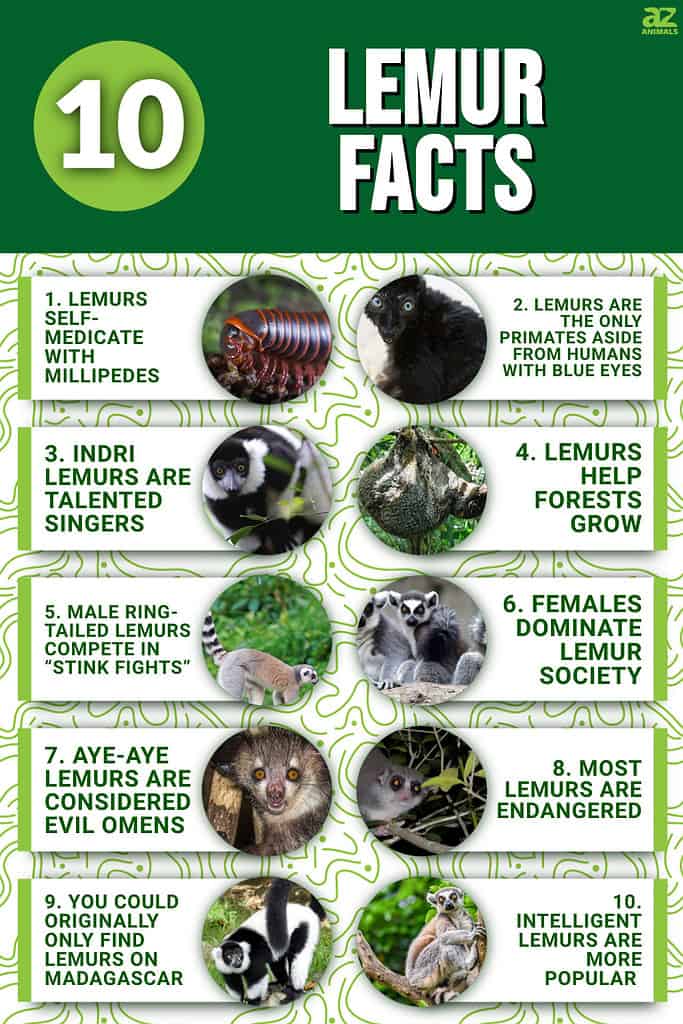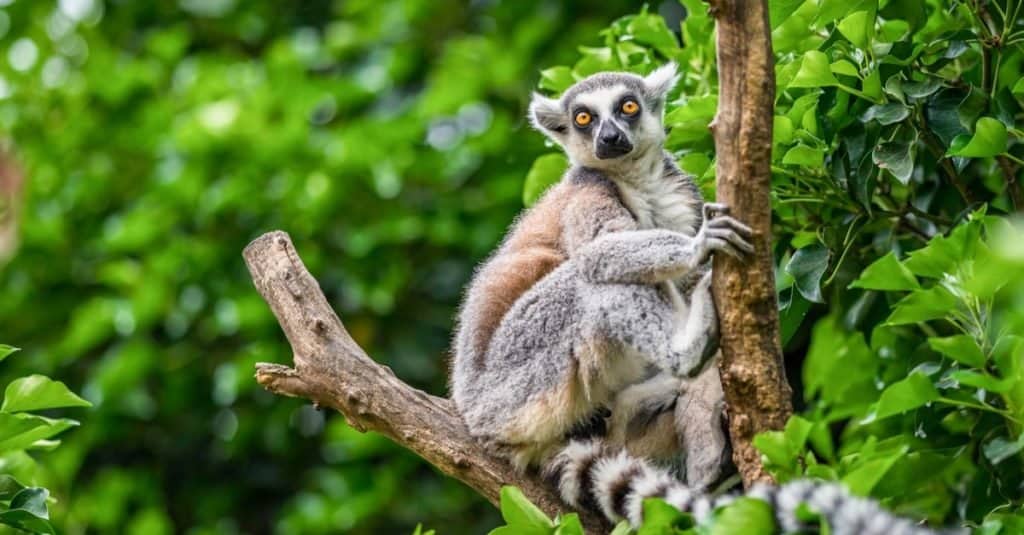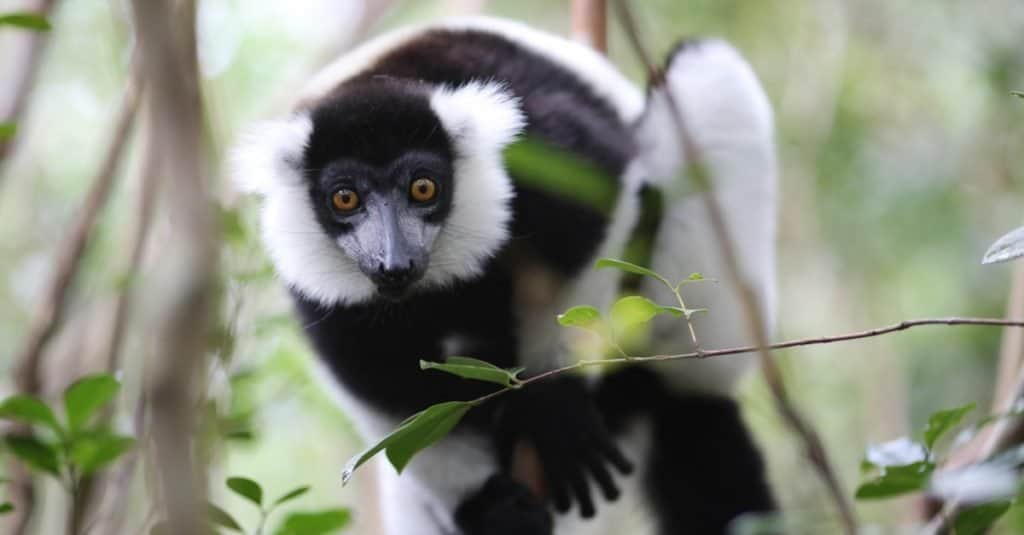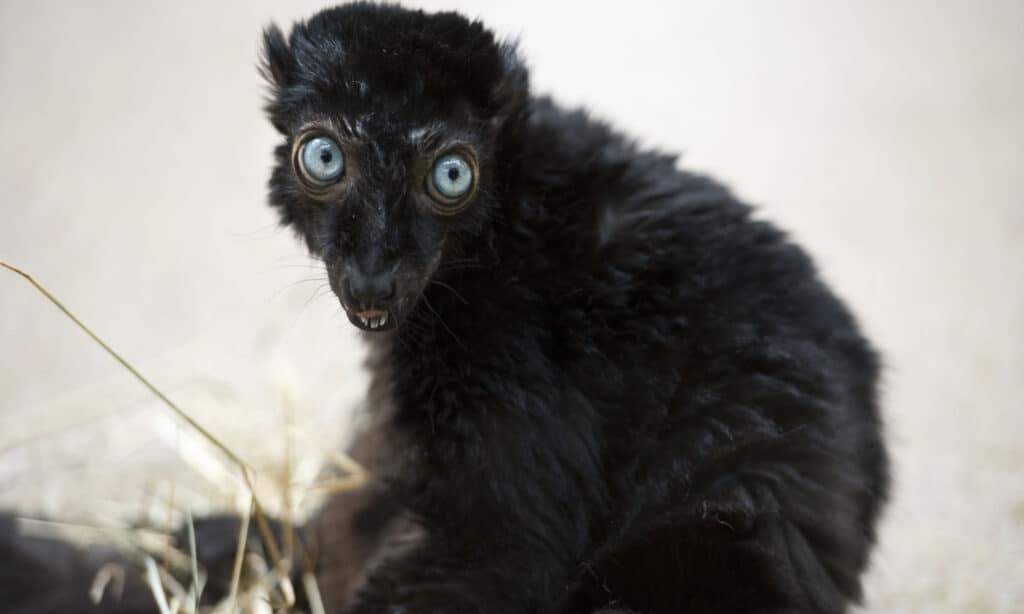Lemurs are a diverse group that includes 8 families, 15 genera, and over 100 different species. They come in a range of shapes, colors, and sizes, such as the tiny 1.1-ounce mouse lemur to the 20-pound indri. A member of the prosimian group of primates that includes all extinct and extant species of tarsiers, lemurs, and lorisids, you can trace their evolution back nearly 70 million years, making lemurs the world’s oldest living primates. Today we’ll discuss 10 incredible lemur facts and cover a few of their most amazing characteristics.

10. Intelligent Lemurs Are More Popular

Lemurs are quite intelligent and tend to be more affectionate toward smart lemurs.
©Ondrej_Novotny_92/Shutterstock.com
Generally speaking, people view lemurs as less intelligent than monkeys. This may be due to the fact that lemurs prefer to manipulate objects with their mouths and don’t often use tools. That said, lemurs still possess keen minds. Although they score lower on some tests than certain monkeys, they also score higher on some other tests. Additionally, lemurs apparently value intelligence within their society.
One study shows that the more a lemur excels at a particular skill, the more popular it becomes within its social circle. In other words, when lemurs observe another lemur completing a task, they tend to act more friendly toward that lemur. The intelligent lemur receives more affection in the form of grooming, touching, or close contact with other lemurs. Essentially, it pays to be clever in lemur society.
9. You Could Originally Only Find Lemurs on Madagascar

Lemurs are endemic to Madagascar and have been introduced to the nearby Comoro Islands.
©J.NATAYO/Shutterstock.com
Lemurs are endemic to the island of Madagascar, which is located off the coast of East Africa. Madagascar’s isolated location and diverse geography meant that lemurs were allowed to adapt to the island’s terrain almost uninterrupted for nearly 70 million years. Over that time, they evolved unique traits that allowed them to thrive in different habitats across the island. Some are large while some are small, some hibernate while some don’t, some breed in certain seasons while some are promiscuous, and some live in large groups while others are solitary. Even today, you can only find lemurs in the wild on Madagascar or a few of the nearby Comoro Islands.
8. Most Lemurs Are Endangered

Most lemurs face threats and are considered Vulnerable or Endangered by the IUCN.
©Frank Vassen from Brussels, Belgium / CC BY 2.0 – License
Until recently, lemurs used to live all across Madagascar. However, when humans arrived on the island around 1,500 to 2,000 years ago, their population, diversity, and range significantly decreased. Hunting, deforestation, and selecting culling all contributed to the dissemination of lemur populations. Moreover, certain species, including several species of giant lemurs, disappeared entirely.
Today, a number of lemurs face continued threats and must struggle to survive. As a result, the IUCN lists the majority of lemurs as either Vulnerable or Endangered species.
7. Aye-Aye Lemurs Are Considered Evil Omens

The Malagasy people consider aye ayes to be evil omens.
©javarman/Shutterstock.com
The word lemur comes from the Latin word Lemures, which were “evil spirits of the dead” in Roman mythology. This choice makes sense given lemurs’ bizarre, vaguely-humanoid bodies and nocturnal lifestyle. Unfortunately, some lemurs’ association with evil spirits has led people to treat them as monsters.
The aye aye lemur is a particularly creepy species of lemur that possesses long, spindly fingers, wild hair, and piercing eyes. It can swivel its especially long middle finger 360 degrees, which it uses to locate insects hiding in tree bark. The local Malagasy people depict the aye aye as a monster in several stories, with one legend stating that an aye aye can curse you if it points at you with its long finger. As the legend asserts that the only way to lift the curse is to kill the aye-aye, this has led to aye ayes being systematically killed or hunted for their meat.
6. Females Dominate Lemur Society

Females tend to dominate lemur society.
©Wang LiQiang/Shutterstock.com
By and large, most mammals lived in male-dominated social groups. The same is true in most primates as well, with gorillas and even humans (historically) serving as prime examples. However, while many mammals live in male-dominated social groups, female-based dominance does exist. Orcas, spotted hyenas, and meerkats serve as just a few examples where females normally dominate group hierarchies. Similarly, female social dominance tends to be the norm in lemur groups.
Female aggression in lemurs is normally associated with feeding but is also evident in other situations. Additionally, male lemurs act differently toward females depending on the species. For example, male ring-tailed lemur males always act submissively toward females, while male crowned lemurs only act submissive when females act aggressively. Some scientists believe that females dominate lemur society because they have a higher resource need and typically match males in terms of fighting ability.
5. Male Ring-Tailed Lemurs Compete In “Stink Fights”

Male ring-tailed lemurs put smells from glands on their wrists and shoulders on their tails and wave them at rivals.
©ehtesham/Shutterstock.com
The ring-tailed lemur is possibly the most well-known lemur species due to its long, black and white ringed tail. However, a little-known fact about ring-tailed lemurs is that they utilize chemical warfare. Male ring-tailed lemurs often compete with each other for food, territory, and access to mates. Rather than settle these disputes over resources with their claws and teeth, they utilize a different method: “stink fights.”
Male ring-tailed lemurs possess scent glands located at the shoulders and wrists. When they get into a brawl with another male, they run their tail across the glands, thereby absorbing the odor into their fur. Sometimes, they even mix several scents together to increase the pungent power of their tails. They will then flick their tails at each other and waft noxious fumes at each other in an attempt to scare off their rivals.
4. Lemurs Help Forests Grow

Lemurs act as seed dispersed and pollinators, thereby helping to grow forests.
©Cheng Wei/Shutterstock.com
Overall, lemurs exhibit a high degree of variability in terms of their diet. While some species eat mostly plant matter, others consume insects and fruits primarily. Regardless, the majority of species prefer to eat an herbivorous diet. Over millions of years, lemurs evolved a very close relationship with a number of Madagascar’s native plants. In fact, their eating habits unwittingly help to maintain the island’s biological diversity.
Lemurs effectively act as seed dispersers for a number of plants across the island. When feeding, they get pollen or seeds stuck to their fur. They then pass the pollen and seeds on to other flowers and plants, thereby enabling their continued production. Lemurs also disperse seeds when they eat fruit. The seeds pass through their digestive tract, which allows certain seeds to germinate.
3. Indri Lemurs Are Talented Singers

Indri’s sing together for group cohesion and defense.
©Iryna Art/Shutterstock.com
Few mammals sing, and the same is true amongst primates, with humans serving as the most notable exception. However, we humans can’t call ourselves the only primates with musical talents. In addition to ranking as the largest extant lemurs, indris are also the only lemurs that sing.
Also known as babakotos, indris live in small family groups along the eastern half of Madagascar. Their songs last anywhere from 45 seconds to a few minutes and include distinctive, loud vocalizations. Indris tend to sing together as a group, and individual members will copy each others’ notes and rhythms. They do so to form group cohesion and also as a form of defense. However, evidence suggests that younger lemurs occasionally sing out of sync with the rest of the group, perhaps to attract attention or assert dominance.
2. Lemurs Are the Only Primates Aside From Humans With Blue Eyes

Sclater’s lemurs, are the only primates aside from humans with blue eyes.
©FeyginFoto/Shutterstock.com
The majority of mammals have brown or dark eyes, and the same is true for primates. Of the more than 600 documented primate species, only two possess blue eyes: humans and blue-eyed black lemurs.
Also known as Sclater’s lemurs, blue-eyed black lemurs live in a limited range. You can find them only in a small area on the Sahamalaza Peninsula in northwest Madagascar and a strip of forest on the adjacent mainland. Scientists only identified them as recently as 2008, making them one of the newer primate discoveries. Unfortunately, these blue-eyed beauties face extinction due to severe habitat destruction, hunting, and the pet trade.
1. Lemurs Self-Medicate With Millipedes

Lemurs chew on millipedes to create an orange substance that acts as a parasite repellent and treatment.
©Gerry Bishop/Shutterstock.com
Although lemurs don’t use tools as often as other primates, that doesn’t mean that they ignore useful resources around them. Case in point, red-fronted lemurs are one of the few primates that self-medicate. They discovered that chewing on millipedes creates an orange paste that acts as a natural mosquito repellent. Red-fronted lemurs take this substance and spread it over their genitals in a bid to rid themselves of harmful parasites. Millipedes function as the lemur’s own natural pharmacy and are used both for prevention and treatment.
The photo featured at the top of this post is © Jearu/Shutterstock.com
Thank you for reading! Have some feedback for us? Contact the AZ Animals editorial team.






